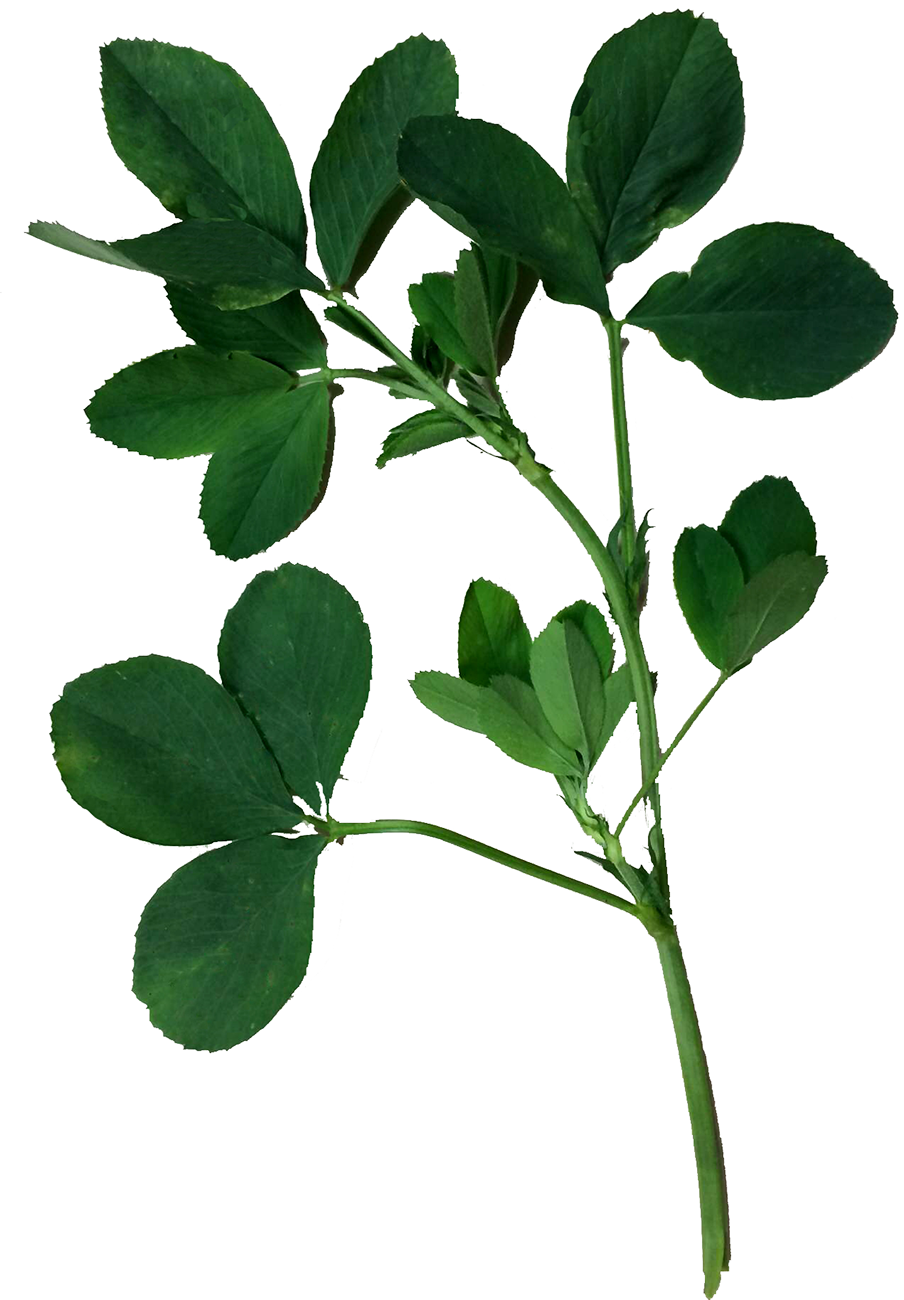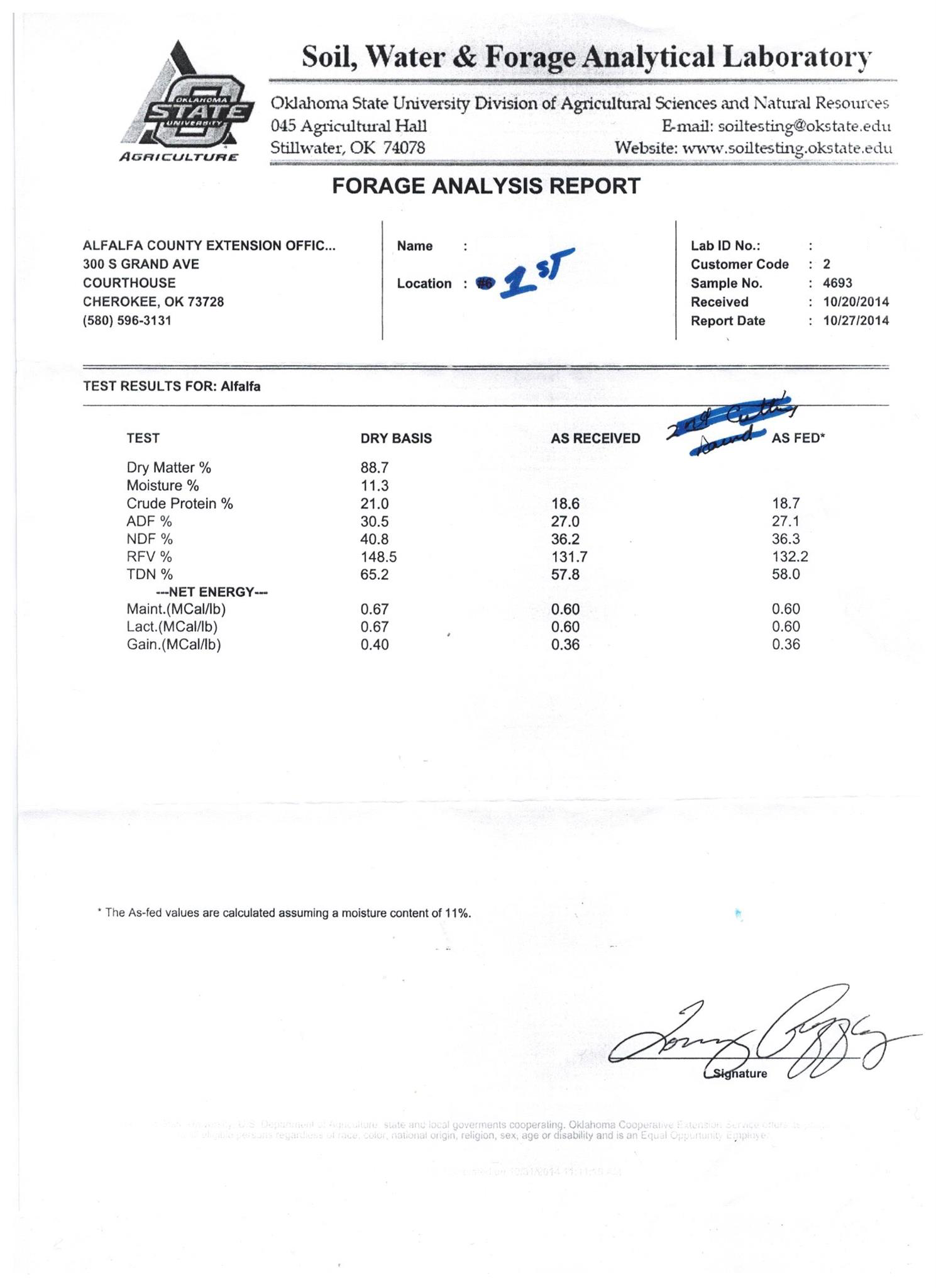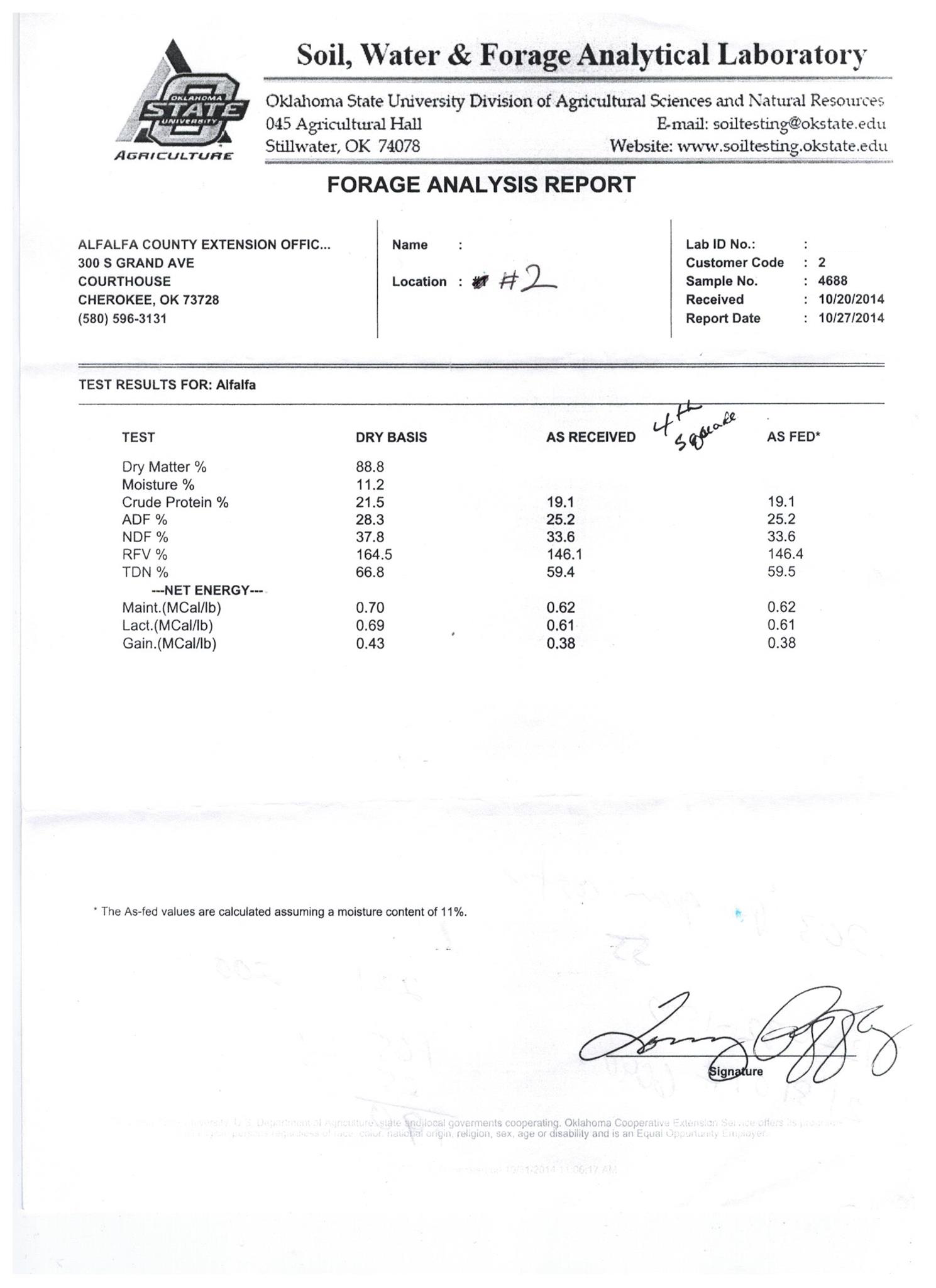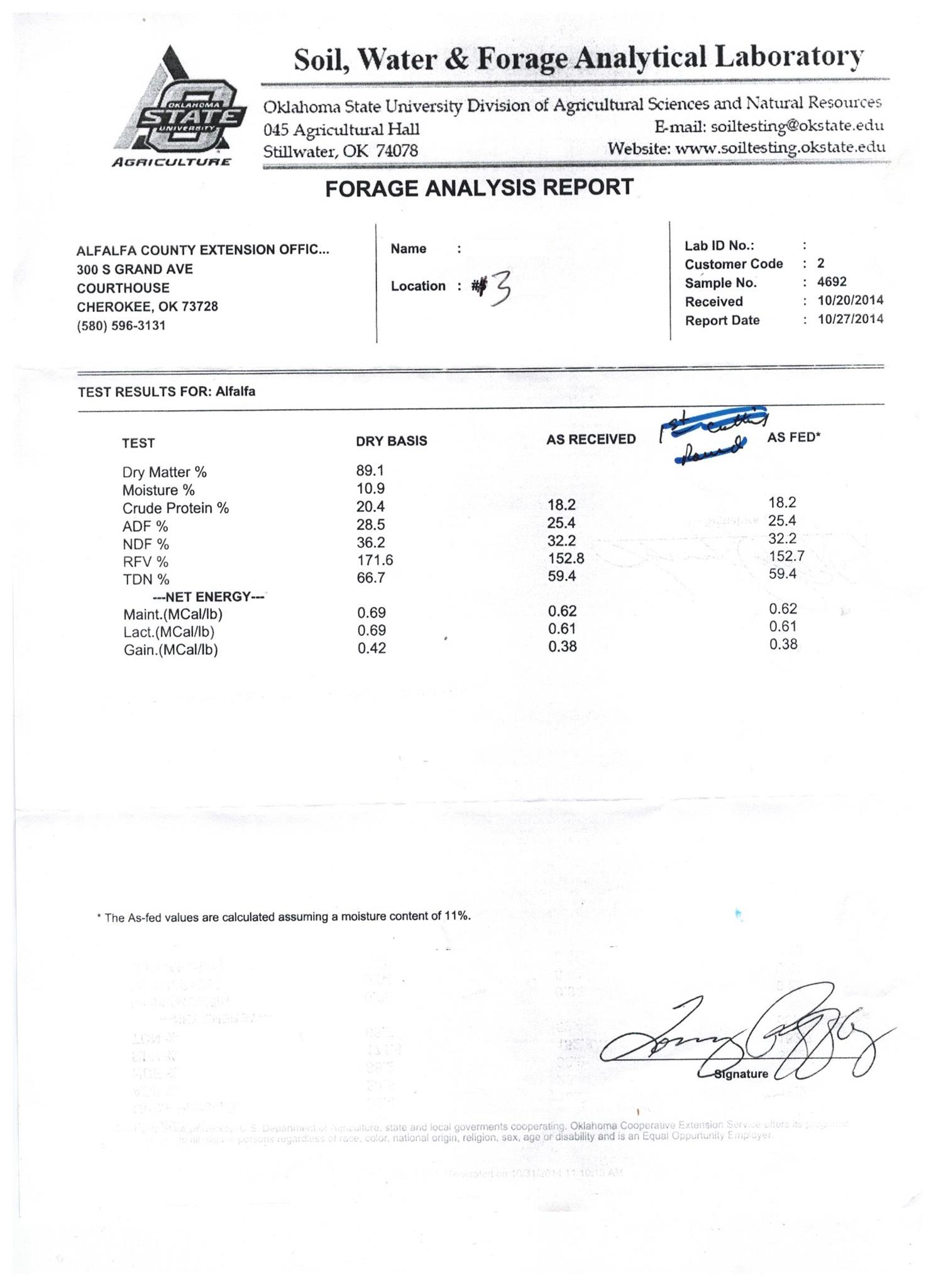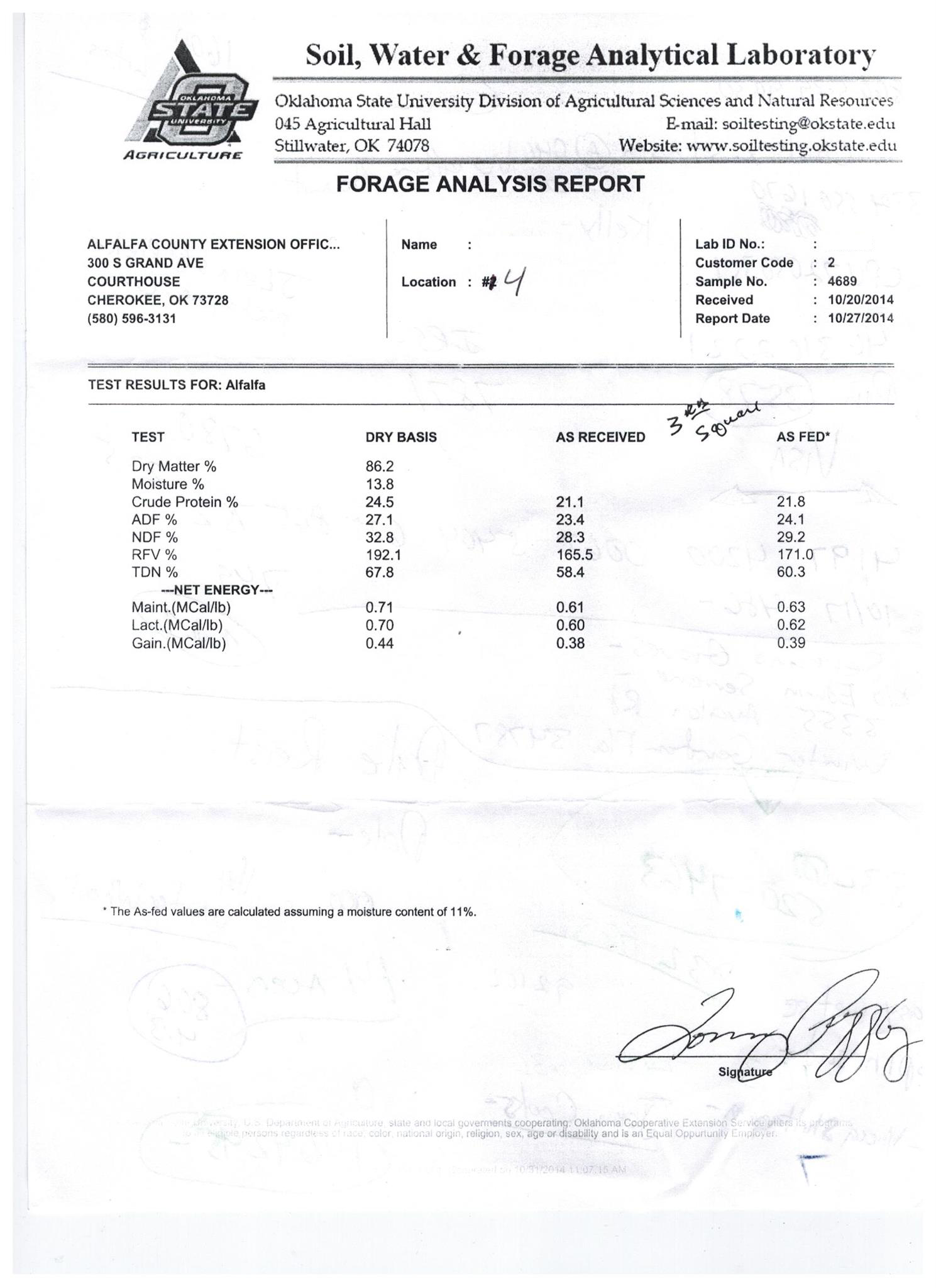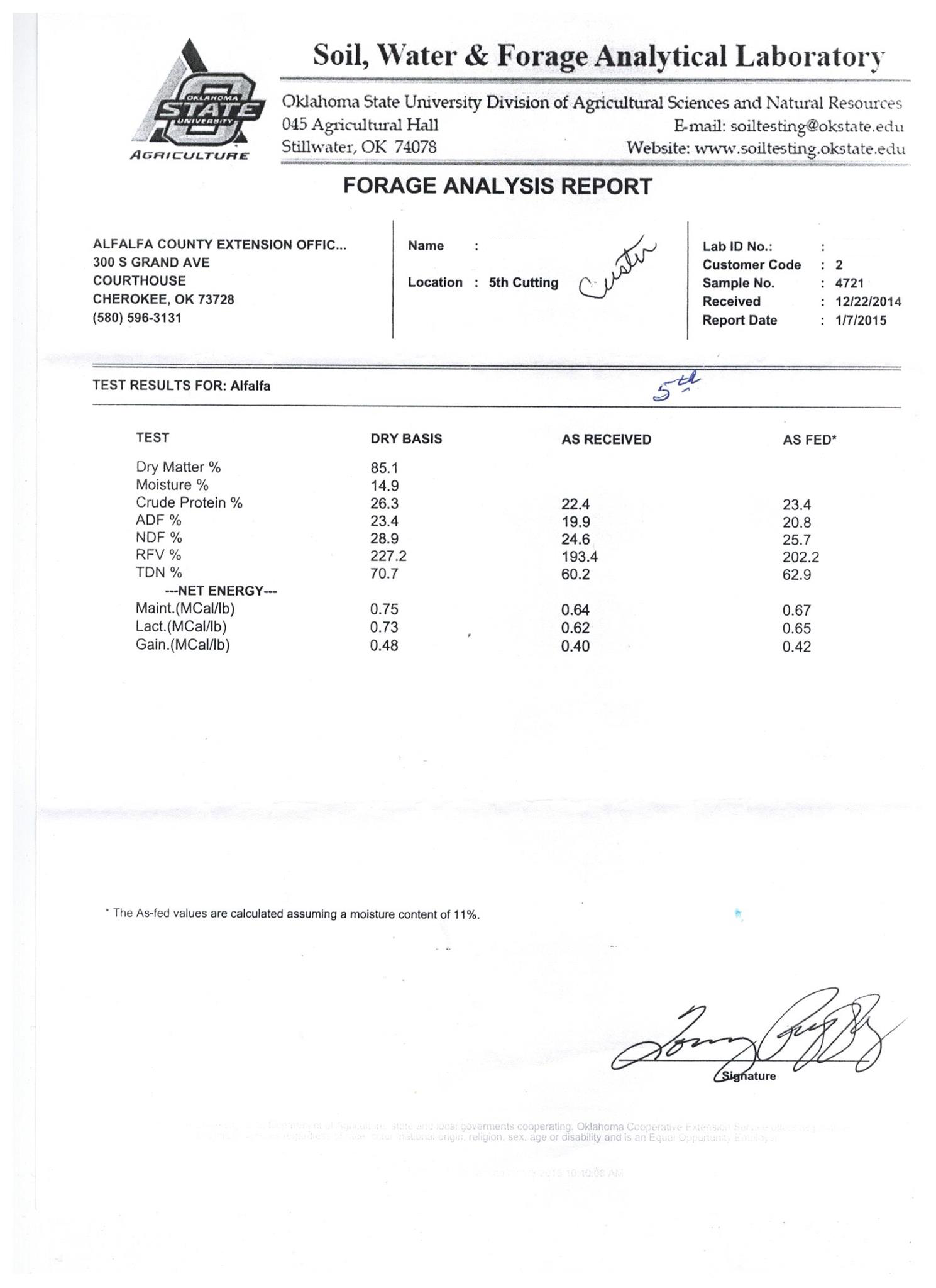BlueGold® for Alfalfa, Hay, Forage Crops
In 1 season went from 1-2 cuttings at 0.5-1 ton per acre to 5 cuttings at 5+ tons per acre on yearling
hay in a drought on dryland Alfalfa with 227.2% RFV and 26.3% Crude Protein on the 5th cutting.
Reversed chemical and pesticide-induced stress, Hollow Stem Syndrome, and yellowing.
Lowered sap Chlorides from 7,200 PPM to 1,070 PPM in 2 foliars resulting in
doubled leaf size and an abundance of lateral internode branching.
Grown pest and disease free with no use of pesticides, herbicides, or fungicides.
Produced a 50% larger yield after 1 application on the 3rd and 4th cuttings.
*In controlled BlueGold® case studies, proper nutrient PPMs in soil and plant sap have yielded these results.
Results are always subject to change due to environmental and other conditions.
ALFALFA IS A NUTRIENT GATHERING MACHINE
with its ultra-deep tap roots
Today when farmers consult on raising nutritious dryland hay, they're mainly told recommendations of 18-46-0 and 0-0-60, keep pH up, cut before blossom, herbicide, pesticide, etc.
If a consultant does not mention excesses and deficiencies in the first conversation, you need to find a new one. It is the excesses first and deficiencies second that are killing your yields.
Alfalfa is a nutrient gathering machine with its ultra-deep tap roots. A lot of farmers are not aware that most of Alfalfa's nutrition is gathered from the atmosphere. The biggest mistake farmers make with Alfalfa is trying to feed it too much Potassium.
Alfalfa is a nutrient gathering machine with its ultra-deep tap roots. A lot of farmers are not aware that most of Alfalfa's nutrition is gathered from the atmosphere. The biggest mistake farmers make with Alfalfa is trying to feed it too much Potassium.
If you look at the stem of Alfalfa and see little black dots, this is an indicator of excess Potassium in the plant sap coming from the soil. Excess Potassium in the soil opens up a virus state in the plant. Alfalfa is one crop that gets most all its Potassium from the air. If Potassium is in excess, it will set back the growth and will push the Calcium availability out of the plant.
High Potash and Potassium push available Calcium and Phosphate around. This causes high Nitrate in the cellulose. This, in turn, causes nitrocellulose or 'gunpowder hay'. Recommendations of 0-0-60 will create catastrophic conditions and pest control budgets of $100+ per acre.
If you look at the stem of Alfalfa and see little black dots, this is an indicator of excess Potassium in the plant sap coming from the soil. Excess Potassium in the soil opens up a virus state in the plant. Alfalfa is one crop that gets most all its Potassium from the air. If Potassium is in excess, it will set back the growth and will push the Calcium availability out of the plant.
High Potash and Potassium push available Calcium and Phosphate around. This causes high Nitrate in the cellulose. This, in turn, causes nitrocellulose or 'gunpowder hay'. Recommendations of 0-0-60 will create catastrophic conditions and pest control budgets of $100+ per acre.
Alfalfa is a nutrient gathering machine with its ultra-deep tap roots. A lot of farmers are not aware that most of Alfalfa's nutrition is gathered from the atmosphere. The biggest mistake farmers make with Alfalfa is trying to feed it too much Potassium.
If you look at the stem of Alfalfa and see little black dots, this is an indicator of excess Potassium in the plant sap coming from the soil. Excess Potassium in the soil opens up a virus state in the plant. Alfalfa is one crop that gets most all its Potassium from the air. If Potassium is in excess, it will set back the growth and will push the Calcium availability out of the plant.
High Potash and Potassium push available Calcium and Phosphate around. This causes high Nitrate in the cellulose. This, in turn, causes nitrocellulose or 'gunpowder hay'. Recommendations of 0-0-60 will create catastrophic conditions and pest control budgets of $100+ per acre.
If you look at the stem of Alfalfa and see little black dots, this is an indicator of excess Potassium in the plant sap coming from the soil. Excess Potassium in the soil opens up a virus state in the plant. Alfalfa is one crop that gets most all its Potassium from the air. If Potassium is in excess, it will set back the growth and will push the Calcium availability out of the plant.
High Potash and Potassium push available Calcium and Phosphate around. This causes high Nitrate in the cellulose. This, in turn, causes nitrocellulose or 'gunpowder hay'. Recommendations of 0-0-60 will create catastrophic conditions and pest control budgets of $100+ per acre.
Pest generally always attack the first cutting. This is because the Phosphate is not available in colder temperatures. Phosphate is not available in mass until the soil warms up, but it is the first mineral that the Alfalfa is looking for very early. This is why Fall elemental application and foliars are so important. As the soil sleeps for the Winter, it massages the minerals for availability. It is looking for Phosphate first, Nitrogen second, and very little Potassium third.
Early foliar applications that are plant available with Phosphate and micronutrients can now utilize the pest budget towards nutrition pest attack unhealthy plants. Nutrition reverses the attacks when the plant sap is balanced at 6.4 resistance (pH).
Foliar nutrient applications that work are the best available asset the farmer has in a poor or out of balance soil condition that is being rebuilt. Farmers do not have the time to wait for years for the soil to balance, so we foliar our way to production success as we rebuild. Hollow Stem Syndrome is not a genetic trait. Alfalfa with Hollow Stem Syndrome shows a Phosphate of Boron deficiency as Phosphate of Boron is the activator of Calcium. Calcium will not move into the plant without Phosphate and the Boron activator. Hollow Stem Syndrome is just a lack of proper nutrition and a proper Boron level. It is like rickets to humans only a deficiency.
A Chelated product used on high Western Carbonate soils will cause the hay to lose its leaves when you mow or bale, especially during harvest. The Chelate thins the protoplasm that holds the leaves to the stalk. This is where the Phosphate is so crucial in Western soils. You must have that Phosphate:Calcium ratio intact if you will begin to grow high yield Alfalfa in any soil. Your hay stalks should be full of lateral internodes. You should not only have leaves just on the top.
Early foliar applications that are plant available with Phosphate and micronutrients can now utilize the pest budget towards nutrition pest attack unhealthy plants. Nutrition reverses the attacks when the plant sap is balanced at 6.4 resistance (pH).
Foliar nutrient applications that work are the best available asset the farmer has in a poor or out of balance soil condition that is being rebuilt. Farmers do not have the time to wait for years for the soil to balance, so we foliar our way to production success as we rebuild. Hollow Stem Syndrome is not a genetic trait. Alfalfa with Hollow Stem Syndrome shows a Phosphate of Boron deficiency as Phosphate of Boron is the activator of Calcium. Calcium will not move into the plant without Phosphate and the Boron activator. Hollow Stem Syndrome is just a lack of proper nutrition and a proper Boron level. It is like rickets to humans only a deficiency.
A Chelated product used on high Western Carbonate soils will cause the hay to lose its leaves when you mow or bale, especially during harvest. The Chelate thins the protoplasm that holds the leaves to the stalk. This is where the Phosphate is so crucial in Western soils. You must have that Phosphate:Calcium ratio intact if you will begin to grow high yield Alfalfa in any soil. Your hay stalks should be full of lateral internodes. You should not only have leaves just on the top.
We have always been taught to cut the Alfalfa pre-bloom because the protein is the highest, and this is correct. What has failed to be understood is that the high protein content at pre-bloom is mostly un-digestible protein. This is why any animal will not touch Alfalfa until it blooms about 20% when they have plenty of other forage to eat. Because the animal knows the post-bloom Alfalfa carries a lower protein content, but the digestible protein is the highest at this phase of the plant production.
The plant releases co-enzymes at the start of bloom, as this is what increases the digestibility of the hay. This is why dairy cows eat way more than they should of
The plant releases co-enzymes at the start of bloom, as this is what increases the digestibility of the hay. This is why dairy cows eat way more than they should of
Alfalfa because of the lower pre-bloom digestibility. Animals will eat a third less post-bloom Alfalfa with a high nutrient and lower protein content. Watch the animals, they’ll tell you every time which hay is high in nutrition.
The system seems stuck at 0.5 to 7 tons per acre on average. We consider 18 tons per acre to be a high average. The real potential for Alfalfa, when all nutrients are dialed in, is 20 tons per acre at 28% moisture with a 6 to 6.5 month growing season. Revolutionary water-soluble soil and plant sap testing methods allow us to deliver balanced nutrition into your crop. Witness the real production potential of your farm on the BlueGold® Plant System.
The system seems stuck at 0.5 to 7 tons per acre on average. We consider 18 tons per acre to be a high average. The real potential for Alfalfa, when all nutrients are dialed in, is 20 tons per acre at 28% moisture with a 6 to 6.5 month growing season. Revolutionary water-soluble soil and plant sap testing methods allow us to deliver balanced nutrition into your crop. Witness the real production potential of your farm on the BlueGold® Plant System.

Dryland Alfalfa in Alva, Oklahoma
In one season BlueGold® helped an Oklahoma farmer go from 1-2 cuttings at 0.5-1 ton per acre to 5 cuttings at 5+ tons per acre on yearling hay during a drought on dryland Alfalfa with 227% RFV and 26.3% Crude Protein on the 5th cutting.
Through the decade, industries have risen on the pedestal of technology, advancing and maximizing capabilities and availabilities. Today the Agricultural industry has been operating under a technology developed only 60 years ago. However, due to environmental and entropic side effects, recent reports on maximizing harvest quality and quantity have been dismal.
Farmers in Oklahoma and Texas may reap only one Alfalfa crop and one Bermuda Grass crop this year. Compare this to the normal of three according, to Larry Redmon, a forage specialist at Texas A&M University. He commented in recent years about the continuing plaguing drought. Each year requires more fertilizer and more pesticides to produce marginal results compared to the previous year harvest.
Farmers in Oklahoma and Texas may reap only one Alfalfa crop and one Bermuda Grass crop this year. Compare this to the normal of three according, to Larry Redmon, a forage specialist at Texas A&M University. He commented in recent years about the continuing plaguing drought. Each year requires more fertilizer and more pesticides to produce marginal results compared to the previous year harvest.
We researched and developed BlueGold® to set the Agricultural industry back on track. Using this new technology, one Alfalfa farmer in Alva, Oklahoma, has seen some unprecedented results. His Alfalfa field has undergone a 5-year drought condition like everyone else. Instead of his traditional 0.5-1 ton per acre on dryland established fields, he gained 5+ tons per acre on a newly established dryland field. This brought more than just increased production profit. He has seen the quality of his crop, unlike ever before. Zero pesticides, herbicides, fungicides, etc. where used during the growth of this high quality crop.
Oklahoma State University, after completing their tests of the harvest agreed that his Alfalfa held a quality seldom seen in the industry.
Oklahoma State University, after completing their tests of the harvest agreed that his Alfalfa held a quality seldom seen in the industry.
Click on the image to zoom in
Due to environmental chemical conditions, the water-holding capacity of soil results in minimal water availability to crops. The average soil today in American farms can only hold approximately 16,500 gallons of water per acre due to improper soil conditions. One inch of rainfall produces 27,154 gallons of water per acre! That is an extreme water loss. By correcting the soil through BlueGold® saponin enhanced wetting agents, the water holding capacity of your soil significantly increases! Resulting in larger yields, increased root depth, and overall improved harvest quality.
This stretch of Kansas Alfalfa, near the road, received only ONE application of BlueGold®
- see how greener and leafier it is compared to the Alfalfa to the left of it.
BlueGold® was designed to jam nutrients into the plant sap and soil. The average soil is dead. Completely void of biologicals and nutrition from chemical onslaught.
All life begins with the soil. Soil is a living organism that needs care all year long. Eden’s BlueGold® Plant System is impressively effective. Through foliar and soil feeding, you’re inducing the plant to pull up nutrients from the soil through the roots via electrical stimulation. Simply, it makes soil nutrients rush into the plants via the roots. It mines the soil of nutrients very efficiently, which is an excellent thing as long as we are good stewards by replenishing nutrients to the soil. For example: We have seen as much as 225 pounds of Calcium per acre leave the soil into the plants per year with 5 foliars. Farmers with marginal soil health will use BlueGold® Alfalfa and see excellent results instantly and then, later on, will fall off with pest and disease pressure. This is because the soil was mined of nutrients so efficiently in such a
All life begins with the soil. Soil is a living organism that needs care all year long. Eden’s BlueGold® Plant System is impressively effective. Through foliar and soil feeding, you’re inducing the plant to pull up nutrients from the soil through the roots via electrical stimulation. Simply, it makes soil nutrients rush into the plants via the roots. It mines the soil of nutrients very efficiently, which is an excellent thing as long as we are good stewards by replenishing nutrients to the soil. For example: We have seen as much as 225 pounds of Calcium per acre leave the soil into the plants per year with 5 foliars. Farmers with marginal soil health will use BlueGold® Alfalfa and see excellent results instantly and then, later on, will fall off with pest and disease pressure. This is because the soil was mined of nutrients so efficiently in such a
short time, but no mineral input was done. You want continuous Amazing Results with no pest or disease and increased yields. To do this, you have to put back into the soil what your crops pull out.
Apical’s Plant Sap Analysis Testing, along with plant sap resistance (pH) monitoring, tells us precisely what is available or lacking in the plant instantly. A plant sap resistance (pH) below 6.4 will lock out Calcium, Magnesium, Potassium, and available Salts. Resistance (pH) above 6.4 locks out, Phosphate, Sulfur, Silica, and all Micronutrients. The farther away from the plant sap resistance (pH) slides away from 6.4, the greater the lockout of these nutrients and pest and disease pressures rush into the plant. This is why an effective foliar program is essential to high production. On the BlueGold® Plant System, you get your results back in 24 hrs., and can make the correction in the plant within 48 hrs to increase production all the while.
Apical’s Plant Sap Analysis Testing, along with plant sap resistance (pH) monitoring, tells us precisely what is available or lacking in the plant instantly. A plant sap resistance (pH) below 6.4 will lock out Calcium, Magnesium, Potassium, and available Salts. Resistance (pH) above 6.4 locks out, Phosphate, Sulfur, Silica, and all Micronutrients. The farther away from the plant sap resistance (pH) slides away from 6.4, the greater the lockout of these nutrients and pest and disease pressures rush into the plant. This is why an effective foliar program is essential to high production. On the BlueGold® Plant System, you get your results back in 24 hrs., and can make the correction in the plant within 48 hrs to increase production all the while.

Pesticide, Herbicide, Fungicide Free Alfalfa

Increase Nutrient Density, RFV, TDN, Protein, Growth, Cuttings!
What Makes BlueGold® Unique?
BlueGold® Solutions are formulated from our trade-secret Eden Synergy micronization process. We manufacture without high heat, acids, solvents, or harsh chemicals to reveal higher levels of available nutrients and to preserve inherent all-natural biological strains and enzymes. We further complex our Solutions with NOP Compliant Plant Saponins and Carbohydrates to maximize immediate nutrient bioavailability in the soil and plant sap. Balanced nutrition is water-soluble deliverable nutrition.
Wetting Agents are a proven crop management tool. Wetting Agents, or surfactants, make water wetter, thereby increasing the penetration of water into soil deeper and broader. Water, as Agriculture’s most used carrier liquid, mixes with materials infinitely more efficiently when water tension is reduced via Wetting Agents.
As the water penetrates deeper and broader into the soil, the nutrients being carried with it also penetrate deeper and broader. This gains an immediate benefit in reduced runoff and burn off of nutrients. In the case of soil with proper biology levels, the nutrients are taken deeper straight to the biology for more efficient processing.
Additionally, wetter water is also known to break down salt bonds, petro bonds, and more quickly hydrate dry soils. Most Wetting Agents on the shelf today are formulated from harsh, caustic detergents or ethoxylated surfactants. These introduce harsh pH solutions into your soil, destroy soil ecology, and have questionable safety concerns.
As the water penetrates deeper and broader into the soil, the nutrients being carried with it also penetrate deeper and broader. This gains an immediate benefit in reduced runoff and burn off of nutrients. In the case of soil with proper biology levels, the nutrients are taken deeper straight to the biology for more efficient processing.
Additionally, wetter water is also known to break down salt bonds, petro bonds, and more quickly hydrate dry soils. Most Wetting Agents on the shelf today are formulated from harsh, caustic detergents or ethoxylated surfactants. These introduce harsh pH solutions into your soil, destroy soil ecology, and have questionable safety concerns.
Wetting Agents are a proven crop management tool. Wetting Agents, or surfactants, make water wetter, thereby increasing the penetration of water into soil deeper and broader. Water, as Agriculture’s most used carrier liquid, mixes with materials infinitely more efficiently when water tension is reduced via Wetting Agents.
As the water penetrates deeper and broader into the soil, the nutrients being carried with it also penetrate deeper and broader. This gains an immediate benefit in reduced runoff and burn off of nutrients. In the case of soil with proper biology levels, the nutrients are taken deeper straight to the biology for more efficient processing.
Additionally, wetter water is also known to break down salt bonds, petro bonds, and more quickly hydrate dry soils. Most Wetting Agents on the shelf today are formulated from harsh, caustic detergents or ethoxylated surfactants. These introduce harsh pH solutions into your soil, destroy soil ecology, and have questionable safety concerns.
As the water penetrates deeper and broader into the soil, the nutrients being carried with it also penetrate deeper and broader. This gains an immediate benefit in reduced runoff and burn off of nutrients. In the case of soil with proper biology levels, the nutrients are taken deeper straight to the biology for more efficient processing.
Additionally, wetter water is also known to break down salt bonds, petro bonds, and more quickly hydrate dry soils. Most Wetting Agents on the shelf today are formulated from harsh, caustic detergents or ethoxylated surfactants. These introduce harsh pH solutions into your soil, destroy soil ecology, and have questionable safety concerns.

This is dryland Alfalfa in Cherokee, Oklahoma. The field usually produces 1-2 cuttings per year. This picture shows his 4th cutting while using BlueGold® with enough time for a 5th cutting! In his best year, the farmer told us he usually gets 1-2 tons per acre, and this year his BlueGold® Alfalfa is approaching 5 tons per acre! All of this during an ongoing drought condition.

James Farm in Utah had a 50% Larger Yield on the 4th Cropping of Alfalfa

This is irrigated round up ready Alfalfa (lower yields) in Utah on BlueGold®.

Alfalfa in Utah on James Farm. Usually, this hay produces one stalk with no lateral branching. As you can see, they are very pleased with the additional lateral branching and leaf sets of the Alfalfa stalks they usually do not get. They are excited about the quantity and quality of the BlueGold® hay. This hay is over 2' tall! Also, their hay always has had Hollow Stem Syndrome; since the BlueGold® applications, the stems are all closing up. This is a sign of nutritional value and heavier crop yields over previous yields!

Look how THICK this hay is. This produces more tons per acre. Alfalfa lower leaf production is THICK on BlueGold®.


The nonyielding GMO Alfalfa produces and yields more. The internode spacing here is not normal with GMO Alfalfa, but it is on the BlueGold® program.

[BEFORE] GMO Alfalfa (like below) has tendencies to turn yellow in growth. This comes from high plant sap resistance (pH) that locks out Calcium, Magnesium, Potassium, and available Salts.

[AFTER] This GMO Alfalfa had severe yellowing, before BlueGold. The farmer said his GMO Alfalfa never produced like this and is ecstatic that he is getting such dense, tall growth.



